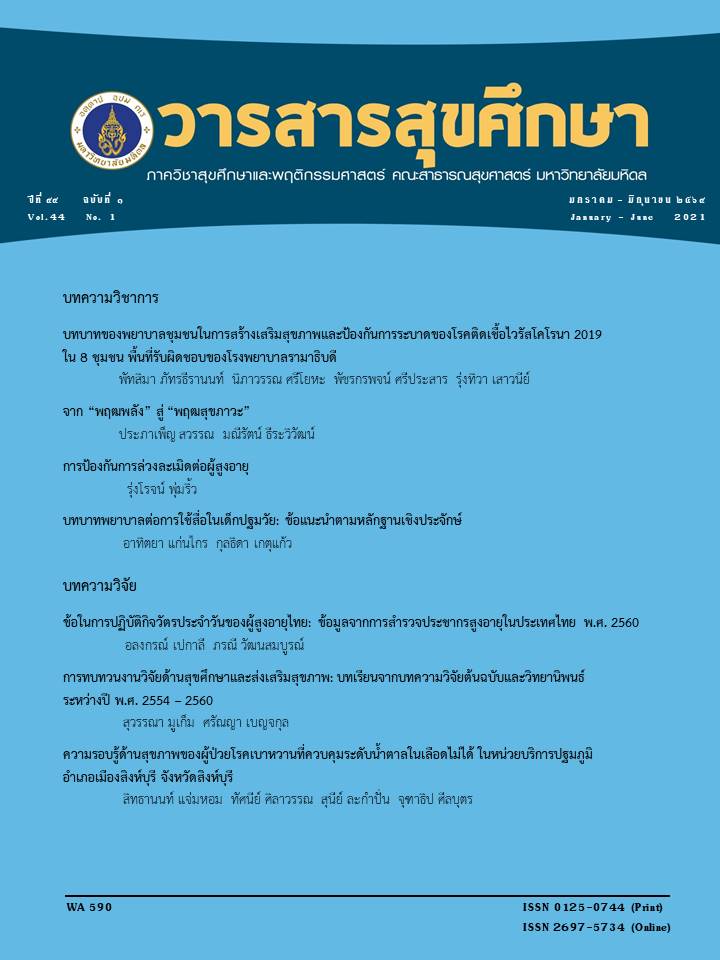From “Active Ageing” to “Healthy Ageing”
Main Article Content
Abstract
The United Nations Organization had developed the Millennium Development Goals—MDGs (2000-2015) and the World Health Organization had developed the strategy of “Active Ageing” with the aim to promote elderly worldwide to access medical/public health services, have good quality of life, be safe and secure and participate in community activities. After the year 2015, the United Nations Organization had set up 17 components of the Sustainable Development Goals: SDGs (2015-1530) whereas the component 3- -“Good health and living” relates directly to health. At the same time, the World Health Organization had developed the strategy on “Healthy Ageing”, 2016-2030, aiming to promote health of elderly worldwide. “Healthy Ageing” Model should include all 4 components of health in regard to physical, mental, social and spiritual health. More activities should be done in Thailand to develop, study, and research the “Healthy Ageing” Model in order to help Thai elderly get holistic components of health.
Article Details
References
World Health Organization. Toward a Decade of Healthy Ageing. Available from http://www.WHO/FWC/ALC/17.1 C WHO 2017. 1996
United Nation, The Sustainable Development Goals [Internet]. [cited 2020 December 1]. available from: https://www.un.org/sustainabledevelopment/
World Health Assembly. The Global strategy and action plan on ageing and health 2016–2020: towards a world in which everyone can live a long and healthy life. World Health Organization. https://apps.who.int/iris/handle/10665/252783 2016.
Gray R. (1996). Active Ageing Index in Thailand: Experience with statistical tools to measure demographic development. Asia-Pacific Workshop on Developing Tools to Measure Inclusive and Active Population Ageing, 28 June, 2019, MR-4, UNCC, Bangkok.
โครงการสุขภาพคนไทย. (2560). สุขภาพคนไทยกับเป้าหมายการพัฒนาที่ยั่งยืนสถาบันวิจัยประชากรและสังคมมหาวิทยาลัยมหิดล นครปฐม: สถาบันวิจัยประชากรและสังคม มหาวิทยาลัยมหิดล. หน้า 78 -79.
สำนักงานสถิติแห่งชาติ กระทรวงดิจิตอนเพื่อเศรษฐกิจและสังคม. ดัชนีพฤฒพลังผู้สูงอายุไทย(Active Ageing Index of Thai Elderly) กรุงเทพฯ: บริษัทเทกซ์แอนด์เจอร์นอลพับลิเคชั่น จำกัด. 2560.
กรมกิจการผู้สูงอายุ กระทรวงพัฒนาสังคมและความมั่นคงของมนุษย์. มาตรการขับเคลื่อนระเบียบวาระแห่งชาติเรื่องสังคมผู้สูงอายุ 2560. [อินเทอร์เน็ต]. 2560 [เข้าถึงเมื่อ 1 มกราคม 2564]. เข้าถึงจาก: http://www.dop.go.th
Rowe JW and Kahn RL. “Successful Ageing”. The Gerontologist 1988;37:433-441.
Linn MW et al. “A Social Dysfunction Rating Scale”. Journal of Psychiatric Research 1969;6:299-306.
Crowther MR, Parker MW, Achebaum WA, Larimore WL and Koenig HG. (2002). Rowe and khan’s Model of successful Ageing Revisited: Positive Spiritually- The Forgotten Factor. The Gerontologist 2002;42(5):613-620.
มูลนิธิสถาบันวิจัยและพัฒนาผู้สูงอายุไทย. รายงานสถานการณ์ผู้สูงอายุไทย 2551 [อินเทอร์เน็ต]. [เข้าถึงเมื่อ 1 มกราคม 2564]. เข้าถึงจาก: http://www.thaigri.org
Ladda Thiamwong, McManus MS and Jom Suwanno. (2013). Development of Thai Healthy Ageing Model: A Ground theory Study, Journal of Advanced Nursing 2013;15(2):256-261.
World Health Organization. Ageing: Healthy ageing and functional ability. [Internet]. [cited 2020 December 1]. available from :https://www.int/ageing/ healthy-aeging/en/
วชิระ เพ็งจันทร์. เกาะติดสถาณการณ์ หลักการดูแลผู้สูงอายุ "ไม่ล้ม ไม่ลืม ไม่ซึมเศร้า กินข้าวอร่อย" [อินเทอร์เน็ต]. [เข้าถึงเมื่อ 1 มกรามคม 2564]. เข้าถึงจาก: http://www.hfocus.org/content/2017/08/144433. 2560.
วชิระ เพ็งจันทร์. เกาะติดสถาณการณ์ หลักการดูแลผู้สูงอายุ "ไม่ล้ม ไม่ลืม ไม่ซึมเศร้า กินข้าวอร่อย" [อินเทอร์เน็ต]. 2560 [เข้าถึงเมื่อ 1 มกราคม 2564]. เข้าถึงจาก: http://www.hfocus.org/content/2017/08/144433
Pilowsky I, Spence ND. Manual for the Illness Behaviour Questionnaire (IBQ) 2. Adelaide, South Australia: University of Adelaide; 1983.
Donald CA and Ware JEJ. The Measurement of Social Support”. Research in Community Mental Health 1984;4:325-370.
ประภาเพ็ญ สุวรรณ. การวัดสถานะทางสุขภาพ : การสร้างมาตราส่วนประมาณค่าและแบบสอบถาม. กรุงเทพฯ: โรงพิมพ์สำนักพิมพ์ภาพพิมพ์. 2037. หน้า 109-112
Fulford RC and StoneG. Touch of Life: The Healing Power of Natural Life Force. Pocket Books, New York. 1996.
มูลนิธิสดศรี -สฤษดิ์วงศ์. การศึกษาและพัฒนาเครื่องมือประเมินและตัวชี้วัดสุขภาวะทางจิตวิญญาณเพื่อการพัฒนา บทสรุปสำหรับผู้บริหาร [อินเทอร์เน็ต]. 2556 [เข้าถึงเมื่อ 1 มกราคม 2564]. เข้าถึงจาก: http://www.thaissf.org


